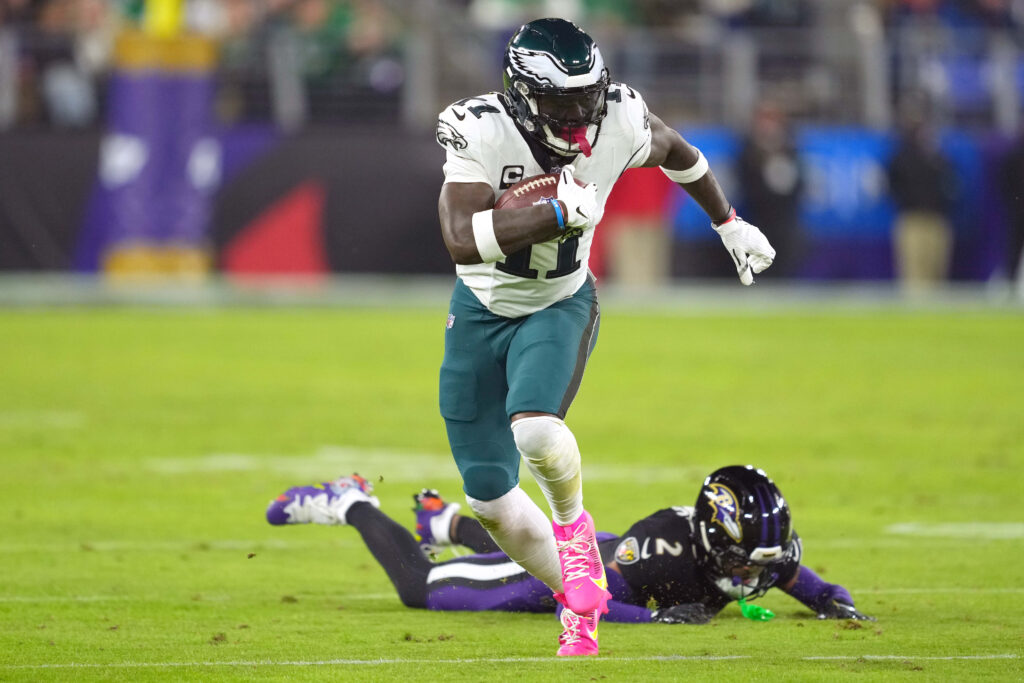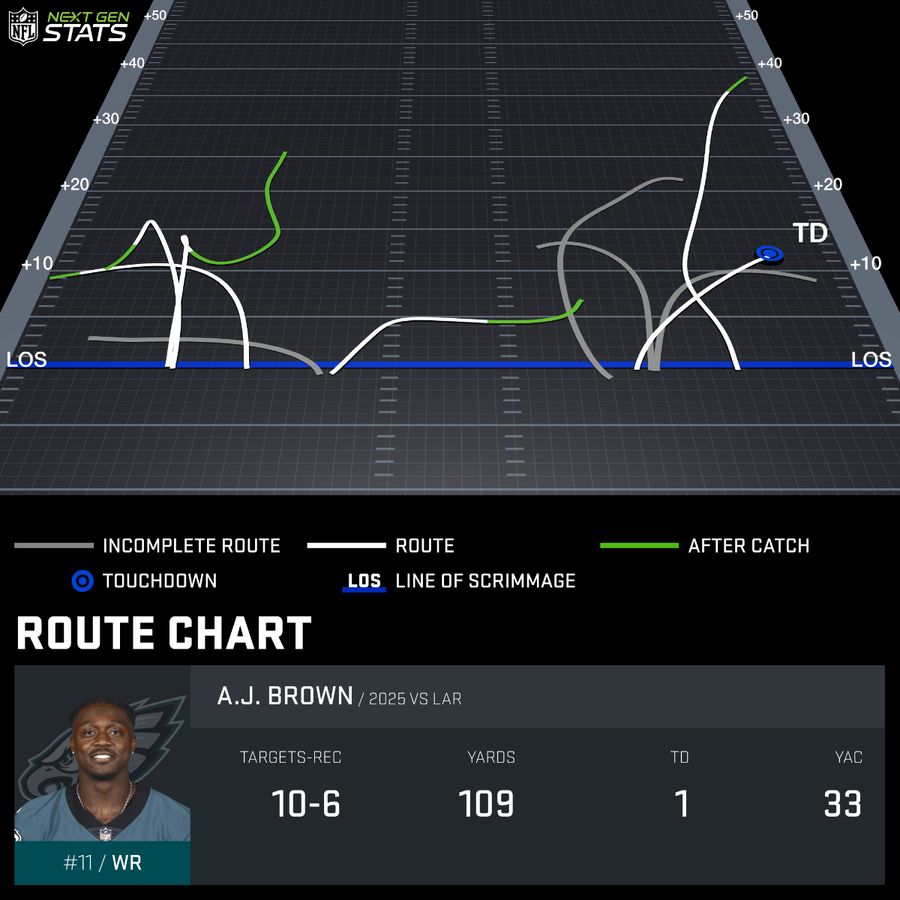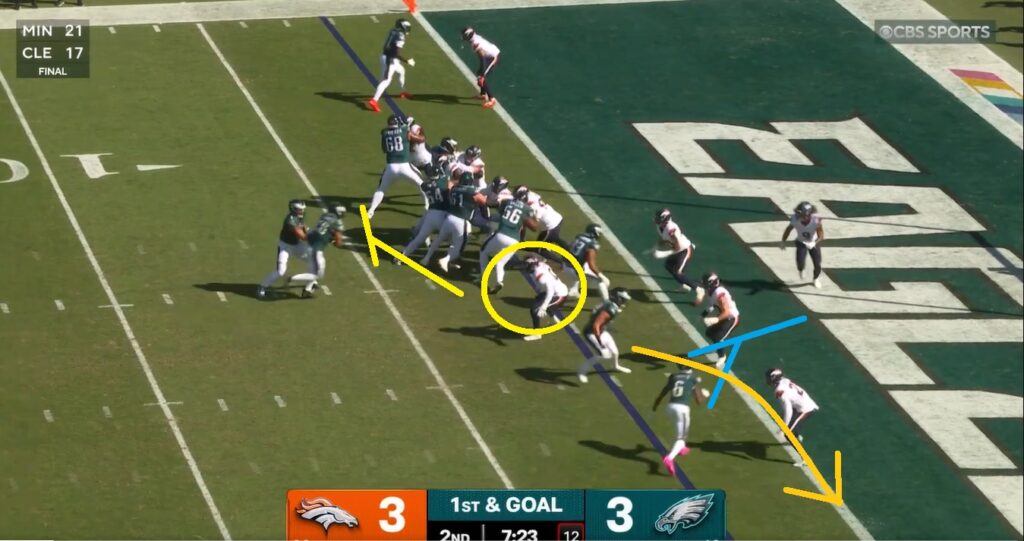Ad Disclosure
Four Offensive Plays the Eagles Need to Run in Every Game, Preferably Multiple Times

With the Eagles’ offense not exactly humming at the moment, there’s been a lot of blathering about “concern,” but less talk about how to fix it. For starters, the line needs to play a lot better. The holes that existed for Saquon Barkley aren’t there this year, and Landon Dickerson has been banged up from the beginning. That’s where a lot of this begins and ends.
Like most things at any level, in any profession, when it’s not working, you go back to basics. You revert to your bread and butter and “build back better” from there. You “perfect vanilla,” as Brett Brown once said, which means executing concepts of strength at the highest level.
In the Eagles’ case, here’s what that looks like:
1) slants for A.J. Brown and/or DeVonta Smith
A.J. Brown has caught 62 of 85 targeted slants since coming to the Eagles in 2022. Those receptions have resulted in 756 yards, 41 first downs, and three touchdowns. He goes for 12.2 yards on average and hauls in 72.9% of these targets.
DeVonta Smith, in the same time frame, has caught 25 of 31 slant targets for 308 yards, two touchdowns, and 17 first downs. That is a 12.3 YPC mark and 80.6% catch rate.
Jalen Hurts throwing the slant to either player has been hugely successful for years now, and they should keep throwing it.
2) A.J. Brown sideline shots and go balls
Most Eagles wins will feature a sideline shot (or two or three) to Brown, who excels on go balls. It’s one of Hurts’ best weapons in his passing repertoire, exhibited in this route chart from the Week 3 win against the Rams:

Statistically, A.J. has caught 26 of 64 go ball targets as an Eagle, going for 1,011 yards and 10 touchdowns. It’s a catch rate of 40.6%, which is a rate that absolutely justifies taking these shots.
Consider that 15.6% of these go balls have resulted in touchdowns and they’re being hauled in a little better than one-third of the time. If you take three shots per game, on average, you’re converting at least one for an explosive or a first down, and forcing the defensive backs to respect the sidelines if they weren’t already.
3) anything from the read and pull tree targeting a tight end
Dallas Goedert has only played five games and yet he leads the Eagles in touchdown passes with 5, while catching 24 of his 33 targets for 243 yards.
One of the targets that has been uber successful for years now is anything going to Goedert (or any TE) that stems from the read and pull tree. If you go back to the touchdown he scored against the Broncos, it’s a simple pull that freezes the EDGE, then a little pick play to hit Goedert on a three-yard out:

Not only do these Goedert targets work very well inside the red zone, but they are always good for 3-5 yards anywhere on the field. If you think about play success rate, which is defined as any play that goes for 40% of the yardage to the line of gain, or goal line, then picking up four yards with this play on 1st and 10 puts you in 2nd and 6 and is considered “successful.”
There’s a larger component here with the Eagles’ RPO game, which Kevin Patullo touched on at his midweek press conference:
Q: Just to follow up, specifically the last two games, have you been satisfied with the amount of times you’ve run the ball, or would you like it to be more? (Bob Brookover)
Kevin Patullo: I would like to increase it, obviously. Some of that that we talked about a week ago is those kind of RPOs that we run where sometimes the runs called, then the ball gets pulled and thrown, and they’ve been successful. But yes, we need to continue to grow in that area.
It does seem like there’s been a lot of pulling on RPO looks, which is fine if that’s what the defense gives you. It’s important because the Eagles have the league’s lowest play-action rate, 4%, but the highest RPO rate, at 18%. So if they can get some balanced running AND passing coming out of those looks, it makes them much less predictable than they’ve been over six weeks.
Only 20 of Saquon Barkley’s 95 carries have come from RPO looks this year (21%), while last year it was 125 out of 345 (36.2%)
4) Barkley B gap runs / more productive inside zone
Saquon Barkley logged 783 of his 2,005 regular season rushing yards when he was hitting the B gaps last year. That means he was running between Landon Dickerson and Jordan Mailata on the left, and Mekhi Becton and Lane Johnson on the right. Over 128 attempts, he averaged an incredible 6.12 yards per carry.
This year? The number is almost halved:

He’s only getting 3.78 yards per carry running the B gaps this year, with Dickerson hobbled or out and Tyler Steen replacing Becton. Mailata and Johnson haven’t been themselves either, just going with the eye test. So this is kind of a combination thing here – #1 they need to get Saquon into his best gaps, but #2 the line has to actually open those holes, and they aren’t doing it right now.
All data from Sportradar
Kevin has been writing about Philadelphia sports since 2009. He spent seven years in the CBS 3 sports department and started with the Union during the team's 2010 inaugural season. He went to the academic powerhouses of Boyertown High School and West Virginia University. email - k.kinkead@sportradar.com